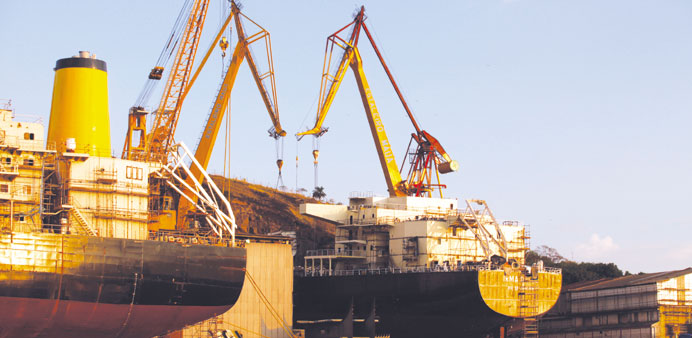Oil platforms sit under repair at the Maua Shipyard in Guanabara Bay in Rio de Janeiro. Brazil’s oil production prospects have risen since deepwater ‘subsalt’ reserves were found in 2007.
Africa and Brazil are more attractive areas for oil and gas exploration than the Arctic, where firms will need 15 to 20 years to tap reserves due to the harsh climate, the chief executive of Norway’s DNV GL said.
DNV GL is one of the world’s largest certification, inspection, testing and advisory companies for the maritime, oil and gas and renewable power industries.
The Arctic is estimated to contain 20% of the world’s undiscovered hydrocarbon resources.
Melting ice due to global warming has created opportunities there for oil and gas companies, but they still face high costs and risks at a time that most oil majors are cutting capital spending.
“Any significant production will be 15 to 20 years away except for the Yamal (peninsula), but that is onshore,” Henrik Madsen, DNV GL Group’s president and chief executive, said in an interview.
“I think there are more attractive areas in the world like Africa and maybe Brazil. There is also lots of shale oil around,” he added.
On the Yamal Peninsula in the Western Siberian Arctic, Russian gas producer Novatek is developing a $27bn liquefied natural gas (LNG) project together with French energy group Total and China National Petroleum Corp.
In Africa, meanwhile, improved seismic techniques and the opening up of more countries to international companies have increased the areas that are on the verge of oil production.
Uganda, Kenya, Ghana and Niger are among countries with new oil fields that could produce over 100,000 barrels per day by the end of the decade, while Mozambique and Tanzania are locked in a race to be the first to export gas from East Africa, Madsen said.
Brazil’s oil production prospects have risen since deepwater “subsalt” reserves were found in 2007, which are estimated to contain 35bn barrels of recoverable oil equivalent, more than double Brazil’s existing reserves.
Since the middle of last year, most major integrated oil and gas producers have announced reductions in their capital expenditure programmes. “All the big oil companies are now a bit more cautious about capital-intensive projects in difficult areas, the Arctic being one of them,” Madsen said.
“In terms of risks, you definitely can do it in a safe and sustainable manner, but you have to do it one step at a time.”
Gazprom has put the development of Russia’s Shtokman gas field in the Barents Sea on hold due to costs, while Royal Dutch Shell has suspended its Arctic drilling programme as part of a wider drive to cut spending.
One third of the Arctic is covered by land; another third consists of the offshore continental shelf with waters mostly less than 500 metres deep, and the rest is made up of ocean waters deeper than 500 metres.
Arctic oil and gas exploration is expected to start in the Norwegian part of the Barents Sea, an area with a maximum depth of 450 metres that is technically easier to develop because waves are less strong than in other areas and warmth from the Gulf Stream keeps it free of ice.
Several firms are already focussed on that area, including Austrian firm OMV, which last year found reserves of up to 164mn barrels of oil.
Other areas could are more difficult.
“The shelf is not explored. It is a big job to do
exploration drilling there and also shooting seismic (surveys)... There is not much new going on in Alaska. Around Greenland it is very early days, and I am not sure that will ever be developed,” Madsen said.
Shipping activity in Arctic areas is also likely to rise in coming years, but the risks will need to be managed, he said.
DNV GL has estimated that the risks are nearly 30% higher for a cruise ship in Arctic waters than on conventional routes due to survival challenges for the people on board.
For bulk carriers, the danger is estimated to be 15% higher because of the risk of colliding with ice.
The Northern Sea Route from the Atlantic Ocean to the Pacific Ocean runs along the Russian Arctic coast to the Bering Strait and Far East.
The entire route is in Arctic waters, parts of which have a surface layer of ice for around 10 months of the year.
“What we fear most is if we get some cowboys up there. It is not easy to navigate, it is quite shallow water, quite narrow straits and there is ice, so you need to have really good captains,” Madsen said.

